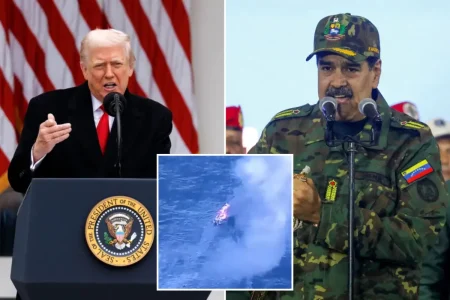U.S. Expands Maritime Interdiction Strategy in Caribbean Waters with Fourth Strike Under Trump Administration
Legal Controversies Surround Escalating Anti-Narcotics Operations in International Waters
In a significant escalation of America’s counter-narcotics efforts in the Caribbean, the Trump administration has executed its fourth maritime interdiction operation against suspected drug traffickers, continuing a campaign that has drawn intense legal scrutiny and international debate. The latest strike, conducted in international waters approximately 200 nautical miles east of the Windward Islands, represents another chapter in the administration’s aggressive approach to combating drug flows from South America toward U.S. shores. Maritime security experts and legal scholars remain deeply divided over the constitutional and international legal foundations of these operations, which occur in a complex jurisdictional environment where national sovereignty, freedom of navigation, and counter-narcotics imperatives frequently collide.
The operation, carried out by elements of the U.S. Coast Guard and naval assets operating under Joint Interagency Task Force South, intercepted a vessel suspected of transporting approximately two tons of cocaine bound for distribution networks in Puerto Rico and the eastern United States. According to senior Defense Department officials speaking on condition of anonymity due to operational security protocols, the interdiction resulted in the detention of seven individuals believed to be connected to Colombian trafficking organizations. “This latest success demonstrates our unwavering commitment to disrupting the flow of illegal narcotics that threaten American communities,” said Admiral Karl Schultz, Commandant of the U.S. Coast Guard, during a press briefing at Coast Guard headquarters. “The Caribbean remains a critical transit zone, and our presence there sends a clear message to traffickers that these waters are not a safe haven for their operations.”
Critics, however, have raised substantial concerns about the legal framework governing these maritime interdictions, pointing to unresolved questions about jurisdiction, due process, and compliance with international maritime law. The American Civil Liberties Union has filed litigation challenging the constitutionality of detaining suspects on naval vessels for extended periods before formal charges are brought in U.S. courts. “These operations exist in a troubling legal gray zone,” explained Professor Margaret Taylor, an expert in international maritime law at Georgetown University. “While the U.S. has legitimate security interests in preventing drug trafficking, these interdictions often occur in international waters where American law enforcement jurisdiction is limited and frequently contested.” Several nations in the region have expressed diplomatic concerns about what they characterize as extraterritorial application of U.S. law enforcement powers, particularly when operations occur near their territorial waters without prior notification or consent mechanisms.
The Evolving Tactics of Caribbean Drug Transportation Networks
The intensification of maritime interdiction efforts comes as intelligence assessments indicate a significant evolution in trafficking methodologies throughout the Caribbean basin. Drug trafficking organizations, particularly those with operational bases in Venezuela and Colombia, have demonstrated remarkable adaptability in response to increased enforcement pressure. Traditional “go-fast” boats have increasingly been supplemented by semi-submersible vessels, legitimately flagged commercial shipping, and sophisticated drone technology for both transportation and surveillance countermeasures. The Caribbean route has seen renewed strategic importance for trafficking networks following intensified enforcement along the Central American corridor, creating what counter-narcotics officials describe as a “balloon effect” where pressure in one geographic area simply redirects trafficking activity to alternative routes.
“We’re witnessing unprecedented sophistication in how these organizations operate in maritime environments,” explained Special Agent Carlos Vasquez of the Drug Enforcement Administration’s Caribbean Division. “They employ advanced encrypted communications, professional maritime crews, and vessels specifically designed to evade detection through minimal radar signatures and thermal masking.” Analysis of seizure data over the past eighteen months reveals a 37% increase in cocaine movement through Caribbean waters, with particularly concerning spikes in activity around the Dominican Republic, Jamaica, and the eastern approaches to Puerto Rico. This regional shift has prompted the reallocation of surveillance assets, including the deployment of additional maritime patrol aircraft operating from forward bases in Puerto Rico and naval facilities in Key West, Florida. The most recent interdiction exemplifies this strategic pivot, having been initiated based on intelligence developed through a multinational information sharing network that includes Colombia, Panama, and several eastern Caribbean nations.
The economic dimensions of this enforcement campaign have also drawn increased attention from policy analysts who question the cost-effectiveness of maritime interdiction relative to alternative counter-narcotics approaches. Each operation typically involves multiple vessels, aviation assets, and personnel drawn from various agencies—representing a significant resource commitment in an increasingly constrained fiscal environment. The Congressional Research Service estimates that the average maritime interdiction operation costs between $3.8 million and $7.2 million, depending on duration and assets employed. “The question isn’t whether these operations can temporarily disrupt trafficking—they clearly can,” noted Dr. Vanda Felbab-Brown, a senior fellow at the Brookings Institution specializing in illicit economies. “The more fundamental issue is whether this enforcement-heavy approach represents the most effective allocation of resources compared to demand reduction and treatment alternatives that address root causes rather than symptoms.”
Legal Challenges Mount as Enforcement Strategy Faces Judicial Review
The constitutional dimensions of these maritime operations have increasingly come under judicial scrutiny, with federal courts in Florida, New York, and Puerto Rico examining challenges to the legal framework supporting extended detentions at sea. Defense attorneys representing individuals apprehended in previous interdictions have filed motions challenging both the jurisdiction of U.S. courts over activities in international waters and the admissibility of evidence collected during what they characterize as extrajudicial detentions. The Trump administration has vigorously defended these operations, citing both statutory authorities under the Maritime Drug Law Enforcement Act and international legal frameworks established through bilateral agreements with flag states and the United Nations Convention Against Illicit Traffic in Narcotic Drugs and Psychotropic Substances.
“These interdictions operate within a well-established legal framework that balances legitimate law enforcement objectives with appropriate procedural protections,” stated Robert Brewer, U.S. Attorney for the Southern District of California, whose office has prosecuted several cases stemming from Caribbean interdictions. “The maritime environment presents unique operational challenges that courts have consistently recognized require specialized approaches to evidence collection and suspect processing.” Nevertheless, several federal judges have expressed reservations about the constitutional implications of extended maritime detentions without prompt judicial review, particularly in cases where suspects have been held for weeks aboard Coast Guard vessels before being presented to magistrates in U.S. territorial jurisdiction. The Supreme Court has thus far declined to directly address these questions, denying certiorari in two cases that might have provided definitive guidance on the constitutional boundaries of maritime interdiction practices.
The most recent operation underscores the ongoing tension between aggressive enforcement objectives and the complex legal environment governing maritime interdiction. As these operations continue to form a cornerstone of the administration’s counter-narcotics strategy, the unresolved legal questions surrounding jurisdiction, detention practices, and evidentiary standards will likely remain contentious issues in both courtrooms and international diplomatic forums. For the individuals detained in the latest Caribbean interdiction, these abstract legal debates now represent the concrete reality that will determine their future judicial proceedings and potential criminal liability under U.S. law. Meanwhile, as trafficking organizations continue to adapt their methodologies and routes in response to enforcement pressure, the cat-and-mouse game across Caribbean waters shows no signs of abating—ensuring that both the operational and legal dimensions of this maritime campaign will continue to evolve in the coming months.










